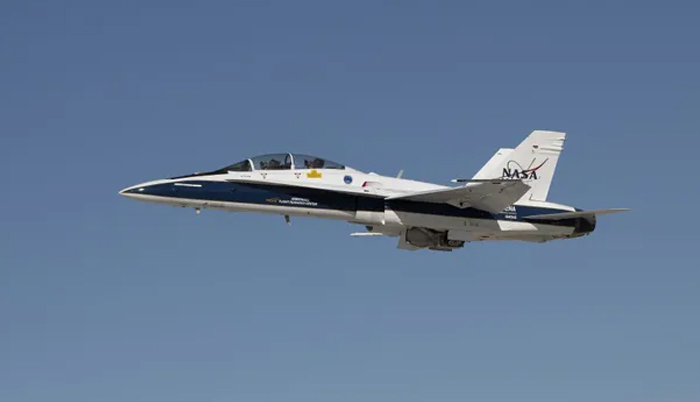![]() Home > Space & Science
Home > Space & Science
NASA Is 'Learning To Listen To The X-59' By Simulating Sonic Thumps With Fighter Jets (Photos)

NASA Armstrong Flight Researcher Center pilot Jim Less flying one of the agency's F/A-18 Hornet jets. (Image credit: NASA/Carla Thomas)
![]() February 11th, 2024 | 01:09 AM |
February 11th, 2024 | 01:09 AM | ![]() 453 views
453 views
SPACE
NASA's F/A-18 and F-15 jets are commonly used as chase planes, but are sometimes used for research.
Before NASA's new X-59 supersonic jet can break the sound barrier, scientists had to record equivalent sonic booms to use for reference.
Test pilots with NASA's Armstrong Flight Research Center took to the skies high above the Southern California desert near the U.S. Air Force's Edwards Air Force Base in order to generate "thumps" the X-59 "Quesst" supersonic jet is expected to produce. Unlike a typical thunderous sonic boom, the sound of the X-59 breaking the sound barrier is projected to be similar to a car door slamming as heard from indoors.
To simulate this sound, NASA's test pilots flew the agency's F-15D Eagle and F/A-18 Hornet support aircraft over a system of microphones installed at 10 ground stations spread across 30 miles (48.3 kilometers) of the desert. By performing inverted (upside-down) dives, the jets were able to produce "softer" sonic booms to be compared against those expected to be produced by the X-59, according to NASA.
NASA's F/A-18 and F-15 jets are commonly used as chase planes, meaning they provide a way to monitor research flights of other aircraft and vehicles from the air. Both aircraft feature two-seat cockpits, allowing for both a pilot and a photographer or videographer to fly onboard.
These recent tests using the agency's "fighter" jets were the third phase of what NASA calls the "Carpet Determination in Entirety Measurements flights," or "CarpetDIEM."
CarpetDIEM is designed to validate upgraded ground recording systems; the agency says both "loud and soft" sonic booms were produced and recorded in order to verify these recording systems that NASA will use during X-59 testing.
In addition to the microphone ground stations, scientists at Armstrong Flight Research Center installed three weather towers and a sonic anemometer (that measures wind speed and direction) to collect weather and atmospheric data that can be correlated with the recordings of sonic booms that the F-15D and F/A-19 produced.
NASA's testing plan will involve flying the X-59 over several U.S. cities to collect data about the quieter boom, or "thump," it makes when breaking the sound barrier. The agency also wishes to learn how the public perceives and responds to the craft, according to a statement.
If all goes to plan, NASA will take the data it collects during its X-59 testing campaign to the Federal Aviation Administration and international regulators to potentially amend current regulations that prohibit supersonic travel over land. The agency says supersonic overland flight could not only enable faster commercial travel, but also shorten response times for medical emergencies and speed up shipping.
One of the ways the X-59 is able to break the sound barrier without generating a deafening sonic boom is through its unique geometry. The sharp, elongated nose section of the jet measures 38 feet (11.5 meters) in length, while the entire aircraft comes in at 99.7 feet long (30 m).
The long, duck-bill-like nose also means pilots won't be able to see out of the front of the aircraft — in fact, it doesn't even feature a forward wind screen. Instead, the X-59 uses a forward-facing, closed-circuit camera and augmented reality display known as the External Vision System, or XVS.
The X-59 is designed to reach a speed of Mach 1.4, or 925 mph (1489 kph) while flying at an altitude of 55,000 feet (16,764 m) and is powered by a single engine built by General Electric Aviation.
Source:
courtesy of SPACE
by Brett Tingley
If you have any stories or news that you would like to share with the global online community, please feel free to share it with us by contacting us directly at [email protected]